Birthstones by the Month
One of The December Birthstones is Tanzanite
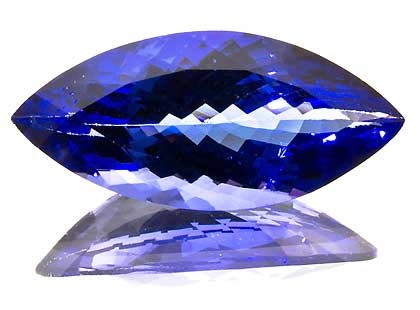
Tanzanite Marquise Cut
This marquise cut tanzanite gemstone shows the natural beauty if the crystal in the form of a gemstone. [1]
Tanzanite Mineral
Tanzanite is a zoisite mineral formation made from calcium aluminium silicate. The structure of Tanzanite or orthorhombic, meaning the crystal system grows with three axes of unequal lengths. Tanzanite is a transparent to translucent clarity with a vitreous luster similar to glass.
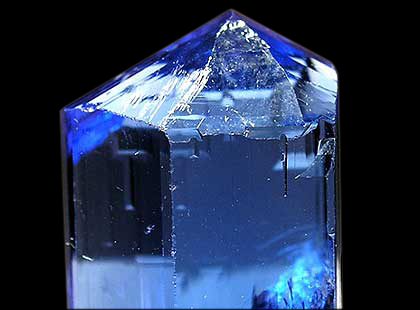
Gem quality Tanzanite
17.26 carats of gem quality tanzanite. Found in Merelani Hills (Mererani), Lelatema Mts, Arusha Region, Tanzania. [2]
Tanzanite Facts
This rare gem was discovered fairly recently. In 1967 a Masai tribesman stumbled upon Tanzanite and the only source found is in the northern hills of Tanzania. The name Tanzanite was coined by the New York jeweler Tiffany’s, after the country of origin. Despite being found in only one location, Tanzanite’s popularity and use in jewelry exploded after its discovery and with surprising shortsightedness, the carat weight was undervalued at first. Aside from the telltale blue variety, there is a rare form of yellow Tanzanite found in the same mines as the blue.
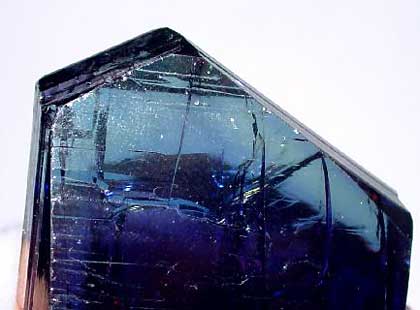
Rough Transparent Tanzanite
This is an impressive crystal. It is so glassy and clean that you can see right through the whole thing and it is brilliantly lustrous and colorful. [3]
The characteristics of Tanzanite
Since Tanzanite has a Mohs hardness of 6 to 6-1/2, it is not a gem abundantly used in rings, since the surface is fairly easily scratched. Tanzanite displays pleochroism, which means depending on the angle of light, the Tanzanite gem may display three or more colors at the same time. According to metaphysical beliefs, Tanzanite is said to help the wearer realize their full potential and has a soothing or calming presence. Tanzanite is also believed to stimulate intuition and increase the wearer’s perception.
Cut and Clarity for the December birthstone
Tanzanite typically has eye-clean clarity, meaning there are inclusions visible only when using magnification. Due to the pleochroism, gem cutters must make their cuts and facets to capitalize on these shades viewed from different angles. Tanzanite is cut into a wide variety of traditional and non-traditional shapes. And, while it is not entirely common, tanzanite has also been cut into cabochons when there is a cat’s eye effect caused from high inclusions.
The value of Tanzanite
There is a surprisingly large range of prices for Tanzanite. Since there is only place on Earth where Tanzanite is mined, this places a monopoly on the source. Tanzanite is expected to run out, unless more mines are discovered, placing a high value on current rough. The pure blue variety of Tanzanite is the most valued, resembling fine sapphire. All saturated colors are more valuable than their paler counterparts. Also, if there are visible inclusions without the use of magnification tools, the value drops dramatically.
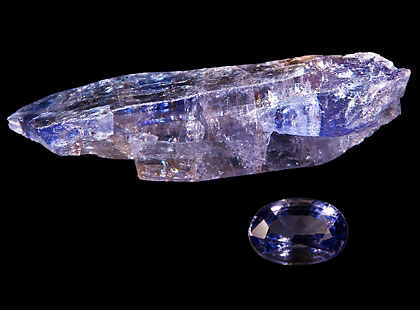
Tanzanite (Zoisite)
Tanzanite shown as rough stone and cut stone from the C-Block Mine in Arusha, Tanzania. [4]
Is Tanzanite ever treated?
Heat treatments are the most common way Tanzanite color is intensified or stabilized. It is possible to change gray, green or brown Tanzanite to a deep violet with a large amount of heat treatment. Since Tanzanite is so heavily heat treated, it is unwise to clean Tanzanite in steam.
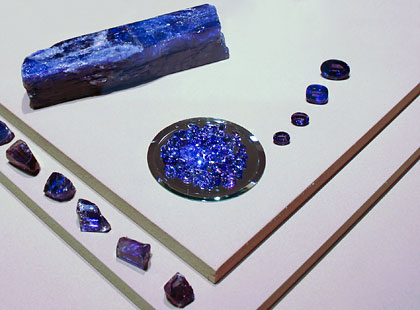
Tanzanite Gemstones
Tanzanite shown in German Museum for Gemstones, Idar-Oberstein. A beautiful display of the December birthstone. [5]
More about Tanzanite the December birthstone
Aside from a birthstone for December, Tanzanite has also seen use in the 24th wedding anniversary. To properly clean Tanzanite it is recommended to just use warm, soapy water over any ultrasonic cleaners or harsh detergents. Make sure the gem and any jewelry settings are fully dry before storing or wearing.
The American Gem Society's December Birthstone page has more information to help you buy from knowledgeable and skilled jewelers and to help you make the most informed buying decision.
Image Attribution
- By Wiener Edelstein Zentrum (Own work) [CC BY-SA 3.0], via Wikimedia Commons
- Rob Lavinsky, iRocks.com – CC-BY-SA-3.0 [CC BY-SA 3.0], via Wikimedia Commons
- Rob Lavinsky, iRocks.com – CC-BY-SA-3.0 [CC BY-SA 3.0], via Wikimedia Commons
- By Didier Descouens (Own work) [CC-BY-3.0] via Wikimedia Commons
- By Beckstet (Own work) [CC BY-SA 3.0 or GFDL], via Wikimedia Commons